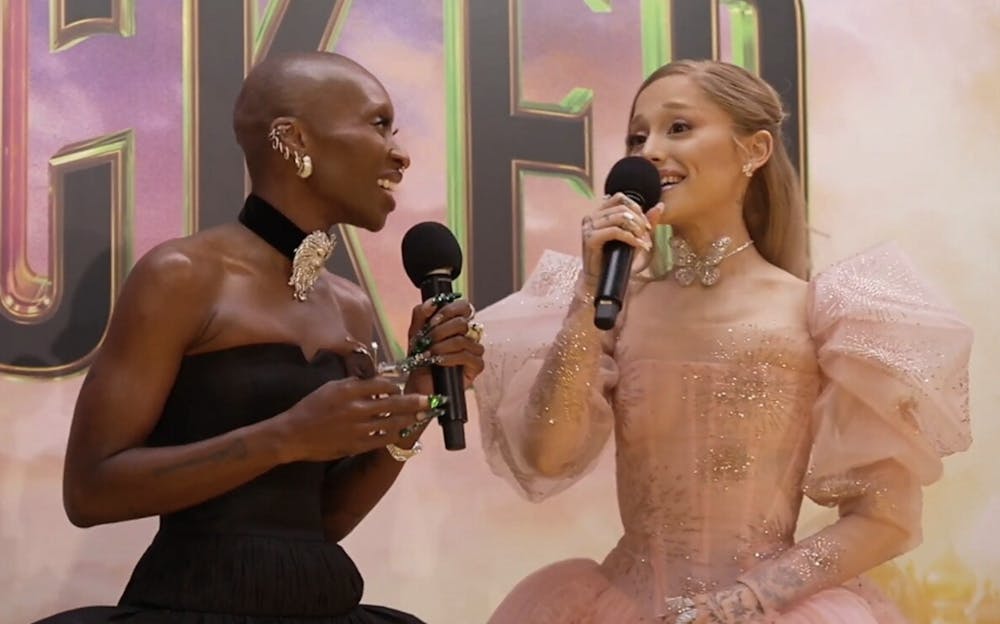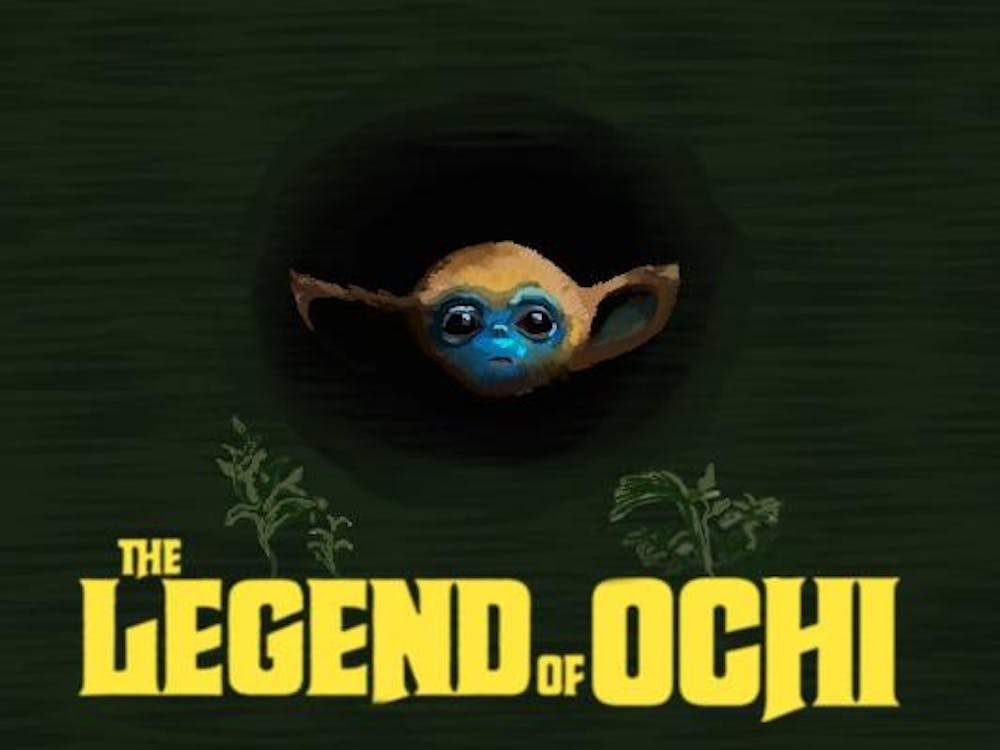If the months-long press tour and myriad promotional rollouts somehow failed to make it clear, “Wicked” is here. “Wicked” is the first of a two-part cinematic series that adapts Stephen Schwartz and Winnie Holzman’s iconic Tony-award winning origin story of the witches of Oz for the big screen — and what an adaptation it is. The set is marvelous, the costumes magnificent and the production unmistakably theatrical — and proud to be so.
Led by Jon M. Chu, director of “Crazy Rich Asians” and “In The Heights,” the project was decades in the making, attempting to serve both as a faithful reconstruction of the iconic stage production and a big-budget blockbuster with mainstream accessibility. Though the task was lofty — especially in a difficult era for musical-to-film adaptations — and the expectations even higher, Chu has certainly succeeded in creating a spectacle, one which is defined by Cynthia Erivo and Ariana Grande, its two powerhouse leads.
Like the Broadway show, the movie “Wicked” opens where “The Wizard of Oz” concludes — the Wicked Witch of the West has melted, and all of Oz can celebrate. “No one mourns the wicked,” they rejoice, and indeed the only person who seems to hold even a hint of remorse at the circumstances is Glinda the Good, played by Grande. Floating down in a pink bubble, she delivers the question at the core of the film — are people born wicked or do they simply have wickedness thrust upon them?
An average viewer of “The Wizard of Oz” would perceive Glinda the Good as the archetypal archnemesis of the Wicked Witch of the West, but Grande quickly explains that the pair not only knew each other, but were students together at Shiz University. And thus the true tale of “Wicked” begins, as the plot flashes back to their first day, when Grande’s Glinda and Erivo’s Elphaba are assigned to be each other’s roommates. Their mutual loathing is evident from their first interaction, frivolous Glinda beloved for her glamorous goodness and reticent Elphaba despised for her green skin.
From her first moments on the screen, Grande shines, embracing the extravagance and comic ethos of Glinda’s character in a fine tribute to Kristin Chenoweth’s originating performance on Broadway. Erivo’s task is the more difficult one, for Elphaba’s is the more difficult disposition to properly capture. While the subtleties in her acting choices are often overshadowed by — and even disappear under — the flashy spectacle of the production, the film’s musical numbers give her a space to show off her talents.
Indeed, it is the film’s musical sequences that truly steal the spotlight. The vocals of both actresses were recorded live on set. This makes it all the more impressive to watch Elphaba bound across barren landscape while maintaining the soaring melody of “The Wizard and I,” or Grande swing from chandeliers and hit high kicks during the iconic “Popular.” So, too, do the ensemble pieces shine. Chu is masterful in his staging of “What Is This Feeling,” which begins as an argument between the two leads but quickly expands to a school-wide extravaganza.
The real showstopper, though, is “Dancing Through Life.” Jonathan Bailey is perfectly cast as Fiyero, Shiz’s resident roguish bad-boy who encourages his classmates to throw their books away in exchange for a night of shameless debauchery and, of course, dancing. The song opens in a beautiful library, where Bailey and supporting dancers slide on books and spin over rotating cylindrical bookshelves, before migrating into the iridescent Ozdust Ballroom and breaking out into full ensemble choreography.
While the original Broadway soundtrack is more gentle in its orchestration of this song, the film’s arrangement picks up the pace. In this way, cinematographer Alice Brooks perfectly captures the sense of reckless ebullience that Fiyero and the number inspire.
Though the film’s orchestration is delightful, many online critics have taken issue with its lighting, with complaints of shots being backlit or lacking contrast. There are certainly examples of this poor capitalization on color, particularly in the “Dancing Through Life” sequence, but Chu also leans heavily into the wide color palette that is at his disposal with CGI, most notably in the film’s iconic final set piece of “Defying Gravity.” The song, which traditionally serves as the culmination of the first act of the Broadway production, finds Elphaba and Glinda set against the backdrop of a remarkable and dusky sunset.
Despite the film’s nearly three-hour runtime, “Wicked” is only the first installment in a two-part adaptation, with “Wicked: Part Two” slated for release on Nov. 21, 2025. The storyline takes its intermission at the same place as the stage production, but manages to do so in a way that feels satisfying rather than jarring. In this way, the production has fallen victim to the larger cinematic trend of multiple part releases, but the real crime is that audiences must wait a full year to hear Bailey’s rendition of “As Long As You’re Mine.”
As the most recent addition to a larger trend of musical to movie adaptations, the release of “Wicked” will also revive a hot topic of recent pop culture conversation — how to market movie musicals to mainstream audiences. Movie musical champions and critics alike took issue when recent releases such as 2024’s “Mean Girls” and 2023’s “The Little Mermaid” were reluctant to allude to their theatricality as Broadway adaptations in their marketing pushes. Predictably, this choice was the cause of much confusion for viewers who entered the theater not expecting Regina George to break out in song.
Unlike these productions, “Wicked” is shameless in its self-identification with its musical theater origins. At a time when even the excellent musical adaptations — Spielberg’s “West Side Story” and Chu’s own “In The Heights” — have difficulty reaching the levels of acclaim they deserve, it is to the credit of “Wicked” that its press and promotion has wholeheartedly embraced its theatrical nature. Not only that, but their strategy seems to be working, as fans of the show freaked out when the first snippets of “Defying Gravity” and “Popular” were leaked from toy microphones and Barbie dolls.
Perhaps in part due to this promotional rollout, the film is projected to gross over $100 million dollars in its opening weekend. Whether or not it will meet financial expectations, the film certainly meets cinematic ones, telling a story of friendship and forgiveness that is equal parts heartwarming and heartbreaking — as Grande and Erivo have made abundantly clear in their teary-eyed press tour.
At its core, “Wicked” is a story of belonging, of the struggles of difference and search for acceptance. With careful consideration of all who have worked with the text before him, Chu crafts a cinematic delight that will be beneficial for movie theaters and beloved by musical theater lovers, leaving audiences singing out the cinema doors and dancing through life.







